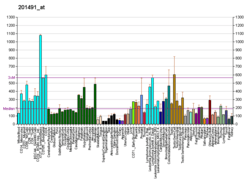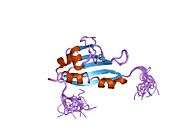AHSA1
Activator of 90 kDa heat shock protein ATPase homolog 1 is an enzyme that in humans is encoded by the AHSA1 gene.[5]
Interactions
AHSA1 has been shown to interact with Heat shock protein 90kDa alpha (cytosolic), member A1.[6]
gollark: Oh, I see. That's not a sentence.
gollark: What are you talking about then?
gollark: "It's" there would make it "you're making my keyboard lose it is confidence". Which is probably wrong.
gollark: No, it means "the confidence belonging to the keyboard", which is right.
gollark: Yes, you're right ABOUT THAT EXAMPLE, but "its" is a real word and a different one.
References
- GRCh38: Ensembl release 89: ENSG00000100591 - Ensembl, May 2017
- GRCm38: Ensembl release 89: ENSMUSG00000021037 - Ensembl, May 2017
- "Human PubMed Reference:". National Center for Biotechnology Information, U.S. National Library of Medicine.
- "Mouse PubMed Reference:". National Center for Biotechnology Information, U.S. National Library of Medicine.
- "Entrez Gene: AHSA1 AHA1, activator of heat shock 90kDa protein ATPase homolog 1 (yeast)".
- Panaretou B, Siligardi G, Meyer P, Maloney A, Sullivan JK, Singh S, Millson SH, Clarke PA, Naaby-Hansen S, Stein R, Cramer R, Mollapour M, Workman P, Piper PW, Pearl LH, Prodromou C (Dec 2002). "Activation of the ATPase activity of hsp90 by the stress-regulated cochaperone aha1". Mol. Cell. 10 (6): 1307–18. doi:10.1016/S1097-2765(02)00785-2. PMID 12504007.
External links
- Human AHSA1 genome location and AHSA1 gene details page in the UCSC Genome Browser.
Further reading
- Hu RM, Han ZG, Song HD, Peng YD, Huang QH, Ren SX, Gu YJ, Huang CH, Li YB, Jiang CL, Fu G, Zhang QH, Gu BW, Dai M, Mao YF, Gao GF, Rong R, Ye M, Zhou J, Xu SH, Gu J, Shi JX, Jin WR, Zhang CK, Wu TM, Huang GY, Chen Z, Chen MD, Chen JL (2000). "Gene expression profiling in the human hypothalamus-pituitary-adrenal axis and full-length cDNA cloning". Proc. Natl. Acad. Sci. U.S.A. 97 (17): 9543–8. doi:10.1073/pnas.160270997. PMC 16901. PMID 10931946.
- Zhang QH, Ye M, Wu XY, Ren SX, Zhao M, Zhao CJ, Fu G, Shen Y, Fan HY, Lu G, Zhong M, Xu XR, Han ZG, Zhang JW, Tao J, Huang QH, Zhou J, Hu GX, Gu J, Chen SJ, Chen Z (2000). "Cloning and functional analysis of cDNAs with open reading frames for 300 previously undefined genes expressed in CD34+ hematopoietic stem/progenitor cells". Genome Res. 10 (10): 1546–60. doi:10.1101/gr.140200. PMC 310934. PMID 11042152.
- Sevier CS, Machamer CE (2001). "p38: A novel protein that associates with the vesicular stomatitis virus glycoprotein". Biochem. Biophys. Res. Commun. 287 (2): 574–82. doi:10.1006/bbrc.2001.5621. PMID 11554768.
- Panaretou B, Siligardi G, Meyer P, Maloney A, Sullivan JK, Singh S, Millson SH, Clarke PA, Naaby-Hansen S, Stein R, Cramer R, Mollapour M, Workman P, Piper PW, Pearl LH, Prodromou C (2002). "Activation of the ATPase activity of hsp90 by the stress-regulated cochaperone aha1". Mol. Cell. 10 (6): 1307–18. doi:10.1016/S1097-2765(02)00785-2. PMID 12504007.
- Lotz GP, Lin H, Harst A, Obermann WM (2003). "Aha1 binds to the middle domain of Hsp90, contributes to client protein activation, and stimulates the ATPase activity of the molecular chaperone". J. Biol. Chem. 278 (19): 17228–35. doi:10.1074/jbc.M212761200. PMID 12604615.
- Swick L, Kapatos G (2006). "A yeast 2-hybrid analysis of human GTP cyclohydrolase I protein interactions". J. Neurochem. 97 (5): 1447–55. doi:10.1111/j.1471-4159.2006.03836.x. PMC 2239266. PMID 16696853.
- Wang X, Venable J, LaPointe P, Hutt DM, Koulov AV, Coppinger J, Gurkan C, Kellner W, Matteson J, Plutner H, Riordan JR, Kelly JW, Yates JR, Balch WE (2006). "Hsp90 cochaperone Aha1 downregulation rescues misfolding of CFTR in cystic fibrosis". Cell. 127 (4): 803–15. doi:10.1016/j.cell.2006.09.043. PMID 17110338.
- Ewing RM, Chu P, Elisma F, Li H, Taylor P, Climie S, McBroom-Cerajewski L, Robinson MD, O'Connor L, Li M, Taylor R, Dharsee M, Ho Y, Heilbut A, Moore L, Zhang S, Ornatsky O, Bukhman YV, Ethier M, Sheng Y, Vasilescu J, Abu-Farha M, Lambert JP, Duewel HS, Stewart II, Kuehl B, Hogue K, Colwill K, Gladwish K, Muskat B, Kinach R, Adams SL, Moran MF, Morin GB, Topaloglou T, Figeys D (2007). "Large-scale mapping of human protein-protein interactions by mass spectrometry". Mol. Syst. Biol. 3 (1): 89. doi:10.1038/msb4100134. PMC 1847948. PMID 17353931.
This article is issued from Wikipedia. The text is licensed under Creative Commons - Attribution - Sharealike. Additional terms may apply for the media files.






